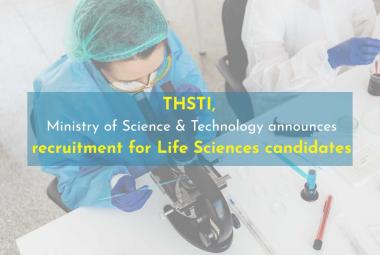{ DOWNLOAD AS PDF }
 ABOUT AUTHOR
ABOUT AUTHOR
JY Manure, NS Naikwade
Department Of Pharmaceutical Chemistry
Appasaheb Birnale College of Pharmacy,
Sangli, Maharashtra, India
Javeedmanure.98600@yahoo.com
ABSTRACT
Cancer is a diseases characterized by out-of-control cell growth. There are various types of cancer, and is classified by the type of cell that is affected. Cancer harms the body when altered cells divide uncontrollably to form lumps or masses of tissue called tumors. The recent treatments include chemotherapy, radiotherapy and Surgery. But this treatment accomplished by several side effect like the destruction of bone marrow cell, alopecia etc. So there is a need for the new drug for treatment of cancer. Plant-derived chemical may act as anticancer in many studies. The Plant produces secondary metabolites which are being evaluated for the anticancer activities leading to the development of new drugs. So in this review we have study different plants which act as anticancer. And this will encourage further scientific study of traditionally used plants.
[adsense:336x280:8701650588]
Reference Id: PHARMATUTOR-ART-2564
|
PharmaTutor (Print-ISSN: 2394 - 6679; e-ISSN: 2347 - 7881) Volume 6, Issue 2 Received On: 27/10/2017; Accepted On: 04/12/2017; Published On: 01/02/2018 How to cite this article: Manure JY, Naikwade NS; A Review on: Plants as Anticancer; PharmaTutor; 2018; 6(2); 40-49; http://dx.doi.org/10.29161/PT.v6.i2.2018.40 |
INTRODUCTION
The cancer disease is characterized continuous multiplication of cell with the inability to be controlled or stopped. Consequently, forming tumors of malignant cells with the potential to be metastatic. Current treatments include chemotherapy, radiotherapy and chemically derived drugs. Treatments such as chemotherapy can put patients under a lot of strain and further damage their health. Therefore, there is a focus on using alternative treatments and therapies against cancer.[ Ochwang’I DO et al. 2014]
For many years herbal medicines have been used and are still used in developing countries as the primary source of medical treatment. Plants have been used in medicine for their natural different properties. The plants extracts preparation shows a potential anticancer effect for the treatment of different types of cancer. [Sivaraj R et al. 2014]
There is need for new drugs evaluation for the treatment of cancer from fruits, vegetables, herbs and spices. Ethnotraditional use of different plant-derived natural products plays a significant role in the discovery and development of potential medicinal agents. [Torres MP et al. 2012]
Grape seeds (Vitis vinifera)
Grape seeds are a good source of polyphenols, which showed a potent antioxidant activity. Thus, grape seed extract (GES) can be used to treat number of deadly diseases like cancer (skin cancer, colon cancer & colorectal cancer) and various bacterial infections. The petroleum ether extracted of Grape seeds analyzed for the cytotoxicity against skin cancer cell lines A431 it showed maximum cell lysis at the concentration of 500 µg/mL. The IC50 value is 480 µg/mL, which indicated that such concentration could lyse 50% of skin cancer cell lines. The morphological changes occurs in treated A431 cell lines when visualized under an inverted light microscope showed that the detachment of the cells from the substratum, cell shrinkage, nuclear condensation and fragmentation. The morphological changes included the reduction in the size of the cells and the cells gradually became shrunken with the appearance of small bodies. Nature and its differential features occurred in the cancer cells it clearly defined the cellular morphological characteristics, which was typical of cell death. The GSE could be used in ointments and also injected as injectable in skin cancer patients to treat skin cancer.[ Mohansrinivasan V et al. 2015]
Tumor cells trigger angiogenesis through over expression of various angiogenic factors including vascular endothelial growth factor (VEGF) and angiopoietin 1 (Ang1). Therefore, inhibition of the expression of both VEGF and Ang1, the initial step of tumor angiogenesis, is a promising strategy for cancer chemoprevention and therapy. Grape seed proanthocyanidins (GSPs) are widely consumed as a dietary supplements that showed antitumor activity. Due to their polymeric structure, GSPs are poorly absorbed along the gastrointestinal tract and can reach the colon at high concentrations, allowing these chemicals to act as chemopreventive agents for colon cancer.GSPs inhibited colon tumor-induced angiogenesis and, thus, the growth of colon tumor xenografts on the chick chorioallantoic membranes. The mechanisms of action were related to inhibiting the expression of both VEGF and Ang1 through scavenging reactive oxygen species. [Huang S et al. 2012]
The grape seed extract (GSE) has the ability to target colorectal cancer (CRC) cells and delineated its mechanisms involved in GSE-induced CRC cell death. GSE have selectively causes apoptotic cell death in human CRC cells; and its efficacy increased as the metastatic potential of the cancer cells increased. GSE intervention may serve as a multi-targeted CRC therapeutic which is capable of inducing selective cancer cell death.[ Derry M et al. 2013]

Fig.1 Grape seeds
Ginger (Zingiber officinale )
Ginger (Zingiber officinale) is a naturally used as dietary component which showed antioxidant and anticarcinogenic properties. The active chemical component present in ginger is[6]-gingerol has been shown to exert anti-inflammatory effects through the mediation of NF-kappaB. The NF-kappaB can be constitutively activated in case of epithelial ovarian cancer cells and may contribute towards increased transcription and translation of angiogenic factors. The effect of ginger and the major ginger components on cell growth was determined in a panel of epithelial ovarian cancer cell lines. Activation of NF-kappa B and and production of VEGF (Vascular Endothelial Growth Factor) and IL-8 ( interleukin-8) was determined in the presence or absence of ginger. Ginger treatment of cultured ovarian cancer cells induced profound growth inhibition in all cell lines tested. Ginger treatment resulted in inhibition of NF-kB activation as well as diminished secretion of VEGF and IL-8. Ginger inhibits growth and modulates of secretion of angiogenic factors in ovarian cancer cells. The use of dietary agents such as ginger may have potential use in the treatment and prevention of ovarian cancer.[ Rhode J et al. 2007]
Despite potential efficacy of [6]-gingerol in cancer, the mechanism by which it exerts chemopreventive effects remains elusive. The leukotriene A(4) hydrolase (LTA(4)H)is a protein which regarded as a relevant target for cancer therapy. In case of In-silico method prediction using a reverse-docking approach revealed that LTA(4)H might be a potential target of [6]-gingerol. [6]-gingerol effectively causes suppression of tumor growth in In-vivo nude mice, and its effect that was mediated by inhibition of LTA(4)H activity.[ Jeong CH et al. 2009]

Fig.2 Ginger
Aloe-emodin
Aloe-emodin (1,8-dihydroy-3-[hydroxymethyl]-anthraquione), which is purified from aloe vera leaves, has been reported to have antitumor activity. The anticancer effects of Aloe-emodin in the T24 human bladder cancer cell line were studied. Cell viability, cell cycle and apoptosis were determined. Levels of cyclins, cyclin-dependent kinase 1 and other enzyme were examined by Western blotting methods. Aloe-emodin which inhibited cell viability, and causes induction of G2/M arrest and apoptosis in case of T24 cells. Aloe-emodin increased the levels of Wee1 and cdc25c, and may have led to inhibition of the levels of cyclin-dependent kinase 1 and cyclin B1, which cause G2/M arrest. AE causes induced of p53 expression and also accompanied by the induction of p21 and caspase-3 activation, which was associated with apoptosis. In addition, AE was associated with a marked increase in Fas/APO1 receptor and Bax expression but it inhibited Bcl-2 expression. Aole-emodin causes apoptosis in T24 cells which mediated through the activation of p53, p21, Fas/APO-1, Bax and caspase-3.[ Lin JG et al. 2006]
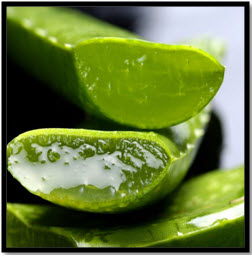
Fig.3 Aloe-emodin
Licorice root (Glycyrrhiza glabra)
Licorice root is a botanical, a shrub native to southern Europe and Asia, which primarily has desirable qualities in sweetening and herbal medicine. Licorice root is one of the oldest and most frequently employed botanicals in Chinese medicine. In the United States, licorice products are most often used as a flavoring and sweetening agents in food products. Constituents of licorice include triterpenoids, such as glycyrrhizin and its aglycone glycyrrhizic acid, various polyphenols, and polysaccharides. A number of pharmacological effects of licorice are known or suspected (anti-inflammatory, antivirus, antiulcer, anticarcinogenesis, and others). Licorice and its derivatives may protect against carcinogen-induced DNA damage and may be suppressive agents as well. Glycyrrhizic acid is act as an inhibitor of lipoxygenase and cyclooxygenase, which inhibits protein kinase C, and down regulates the epidermal growth factor receptor. Licorice polyphenols induce apoptosis in cancer cells. These and other activities of licorice are reviewed, and a rationale is suggested for combinations of agents in preventive clinical trials.[ Wang ZY et al. 2001]
Licorice (Glycyrrhiza uralensis Fisch) root also inhibits active cell proliferation on human breast cancer cell. The cell proliferation study demonstrated that licorice root reduced the proliferation of MCF-7 cells in a dose- and time-dependent manner. The extracts were fractionated in Chloroform, Ethyl acetate, Hexane, and Methanol-Water (70:30), and these extracts of licorice root (50μg/mL) induced DNA fragmentation demonstrated by Hoechst staining. These results were consistent with specific cleavage of PARP and antiapoptotic protein Bcl-2 and up-regulation of proapoptotic protein Bax demonstrated by Western blotting. The licorice root may also possesses chemopreventive effects against human breast cancer through the modulation of the expression of the Bcl-2/Bax family of apoptotic regulatory factors.[ Jo EH et al. 2004]

Fig.4 Licorice root (Glycyrrhiza glabra)
Artemisia annua
Artemisia annua is sometimes also called as sweet Annie, sweet fern, sweet wormwood or annual wormwood. This little known plant recently became the subject of attention when two researchers at the University of Washington noted in 2001 that this wormwood had the potential to become a powerful anti-cancer herb. Artemisia annua showed Antitumor and antiviral properties of the antimalaria drug artemisinin from Artemisia annua. Novel artemisinin derivatives (AD1-AD8) evaluated using in vitro models of liver/colon cancer and viral hepatitis B and C. Cell viability assays after treating human cell lines from hepatoblastoma (HepG2), hepatocarcinoma (SK-HEP-1), and colon adenocarcinoma (LS174T) with AD1-AD8 for a short (6h) and long (72h) period revealed that AD5 combined low acute toxicity together with high antiproliferative effect (IC50=1-5μM.Ferrosanol, but not hemin, enhanced antiproliferative activity of AD5 if the cells were preloaded with AD5, but not if both compounds were added together. Five derivatives (AD1>AD2>AD7>AD3>AD8) were able to inhibit the cytopathic effect of bovine viral diarrhea virus (BVDV). Moreover, AD1 and AD2 inhibited the release of BVDV-RNA to the culture medium. Co-treatment with hemin or ferrosanol resulted in enhanced anti-Flaviviridae activity of AD1. In HepG2 cells permanently infected with hepatitis B virus (HBV), AD1 and AD4, at non-toxic concentrations for the host cells were able to reduce the release of HBV-DNA to the medium.[ Blazquez AG et al. 2013]

Fig.5 Artemisia annua
Tea (Camellia sinensis )
The black, green and herbal tea leaves content a biologically active amino acid (2,4-dinitrophenyltheanine). 80% ethanol/water extracts of the tea leaves showed anticarcinogenic effect in MTT (tetrazolium microculture) assay. Compared to untreated controls, most catechins, theaflavins, theanine, and all tea extracts reduced the numbers of the human cancer cell lines: breast (MCF-7), colon (HT-29), hepatoma (liver) (HepG2), and prostate (PC-3) as well as normal human liver cells (Chang). The growth of normal human lung (HEL299) cells was not inhibited. The destruction of cancer cells was also observed. The anticarcinogenic effects of tea compounds and of tea leaf extracts varied widely and were concentration dependent over the ranges from 50 to 400 μg/mL of tea compound and from 50 to 400 μg/g of tea solids. The different cancer cells varied in their susceptibilities to destruction. [Friedman M et al. 2007]

Fig.6 Tea
Onion (Allium cepa)
Onion (Allium cepa L.) is botanically included in the family Liliaceae and the species are found across a wide range of latitudes and altitudes in Europe, Asia, N. America and Africa. World onion production has been increased by at least 25% over the past 10 years with current production being around 44 million tones making it the second most important horticultural crop after tomatoes. Because of their long term storage characteristics and durability for shipping, onions have always been traded more widely than most vegetables. Onions are versatile and are often used as an ingredient in many dishes and are accepted by almost all traditions and cultures. Onion (Allium cepa) consumption is increasing significantly, day by day particularly in the USA and this is partly because of heavy promotion that links flavour and health. Onions are rich in two chemical groups that have perceived benefits to human health. These are the flavonoids and the alk(en)yl cysteine sulphoxides (ACSOs). Two flavonoid components are found in onion, the first anthocyanins, which impart a red or purple colour to some varieties and flavanols also while second quercetin and its derivatives responsible for the yellow and brown skins of many other varieties. The alk(en)yl cysteine sulphoxides are the flavour precursors, which, when breakdown by the enzyme alliinase, generate the characteristic odour and taste of onion. The downstream products of onion is a complex mixture of compounds which include thiosulphinates, thiosulphonates, mono-, di- and tri-sulphides. Onions contain several anti-cancer compounds, including quercetin, anthocyanins, organosulfur compounds such as diallyl disulfide (DDS), S-allylcysteine (SAC) and S-methylcysteine (SMC) and onionin A (ONA).Onion can be used to suppress epithelial ovarian cancer . [Griffiths G et al. 2002]
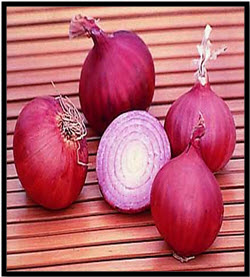
Fig.7 Onion
NOW YOU CAN ALSO PUBLISH YOUR ARTICLE ONLINE.
SUBMIT YOUR ARTICLE/PROJECT AT editor-in-chief@pharmatutor.org
Subscribe to Pharmatutor Alerts by Email
FIND OUT MORE ARTICLES AT OUR DATABASE
Foxglove
The various study on Foxglove showed possible anticancer properties. There are two varieties of this plant, Digitalis purpurea L and Digitalis lanata ehrh. These two have been looked at for their vitro cytotoxicity after polypeptide isolation and extraction. 100 fractionated plant extracts were screened in vitro for cytotoxicity following extraction and fractionation (polypeptide isolation). Of these 100 extracts, 30 were selected for preliminarily for antitumor potency by testing them on cell lines, primary cultures of human tumor cells. On the basis of cytotoxicity potency, 10 of the extracts were further characterized for anticancer activity in 10 human tumor cell lines. This final testing resulted in seven potential lead plants with superior evidence of antitumor potential: Colchicum autumnale L. (Colchicaceae), Digitalis lanata Ehrh. and Digitalis purpurea L. (Plantaginaceae), Helleborus cyclophyllus Boiss. (Ranunculaceae), Menyanthes trifoliata L. (Menyanthaceae), and Viola arvensis Murr. and Viola patrinii Ging. (Violaceae).[ Lindholm P et al. 2002]
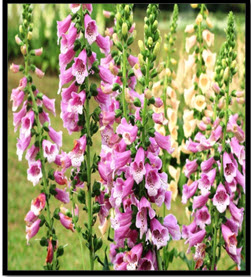
Fig.8 Foxglove
Milk thistle
The study on Milk thistle reported that it showed anti-cancer properties. Milk thistle (Silybum eburneum or Silybum marianum) has an active ingredient in their seeds contain a wide mixture of flavonolignans such as silibinin, silidianin, silicristin, and isosilibinin. Prostate cancer (PCA) is the most common cancer diagnosed in men and the second most common cause of death due to cancers after lung cancer. Metastasis of cancer cells involves multiple processes and various cytophysiological changes, including changed adhesion capability between cells and extracellular matrix (ECM) and damaged intercellular interaction. Silibinin, is a flavonoid which found in Milk thistle, which showed antioxidant and potent antiproliferative effect against various malignant cell lines. PC-3 cells were incubated with various concentrations of silibinin for different times; then, cell cytotoxicity, cell adhesion and cell motility were assessed using MTT assay, cell-matrix adhesion assay and cell migration assay, respectively. The results showed that silibinin exerted a dose- and time-dependent inhibitory effect on the viability, motility and adhesion of highly metastatic PC-3 cells. These observations indicate that silibinin can probably inhibit metastasis in PCA. [Mokhtari MJ et al. 2008]

Fig.9 Milk thistle
Saffron (Crocus sativus)
Saffron is the dry stigmas of the plant Crocus sativus L., contains a carotenoid called crocetin. Saffron used as a spice, a food colorant and also used as an herbal remedy for various ailments including cancer by the ancient Arabian, Indian and Chinese cultures. Crocetin, have a significant antitumor agent in animal model and cell culture system. Crocetin affects the growth of cancer cells by inhibiting nucleic acid synthesis in cell, enhancing anti-oxidative system, inducing apoptosis and hindering growth factor signaling pathways.[ Gutheil WG et al. 2012]

Fig.10 Saffron
Graviola (Annona muricata)
Graviola, is fruit, having natural anti-cancer properties. Graviola (Annona muricata) is an evergreen tree that is used as a remedy for coughs, bacterial and parasite infections, herpes, and arthritis. The extract of Graviola, shows anticancer activity on PC cells. It is revealed that Graviola induced necrosis of PC cells by inhibiting cellular metabolism.[ Torres MP et al. 2012]
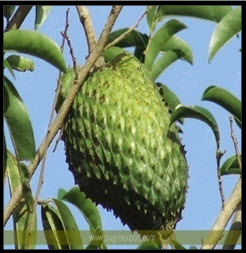
Fig.11 Graviola
Dandelions (Taraxacum officinale)
The Taraxacum officinale, is commonly known as dandelions, have used as traditional medicine in Chinese, Arabian and Native American to treat cancer. The crude extract of Taraxacum officinale shows anticancer effect on MCF-7 cell line by inhibiting the growth of MCF-7 breast cancer cells in an ERK-dependent manner, while the aqueous extracts of dandelion flower (DFE) and root (DRE) had no effect on the growth on MCF-7 [Sigstedt SC et al. 2008]
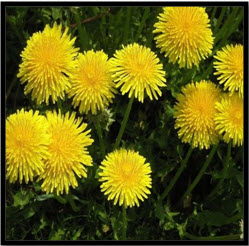
Fig.12 Dandelions
Tessaria absinthioides
Tessaria absinthioides extract exhibits cytotoxicity against cancer cell lines, with no-toxic effects and significant antitumoral effects in colorectal cancer when is orally administrated. The phytochemical analysis of Tessaria absinthioides shows the presence of flavonoids, carbohydrates, sterols, terpenes and tannins. Oral administration of the aqueous extract does not induce acute nor dose-repeated toxicity at doses up to 2000 mg/kg and 1000 mg/kg/day, respectively. The antitumoral effect was confirmed by a significant increase in a median survival from 24 weeks (non-treated) to 30 weeks (Tessaria absinthioides treated). Tessaria absinthioides possesses selective cytotoxicity and antitumoral activities, making its plant derivatives products promising for cancer research and treatment.[ Persia FA et al. 2017]

Fig.13 Tessaria absinthioides
Triterpenoids Secondary metabolites produced by plants are used as therapeutic agents for various diseases, like cancer. Triterpenes are a category of secondary metabolites that exert inhibitory activity against multiple intracellular and extracellular targets in euchariotic cells. These targets are proteins involved in apoptosis, cell development and differentiation, angiogenesis, metastasis and inflammatory processes. The inhibition of their functions leads to decreased cellular growth, differentiation and migration, resulting in antitumor activity, as shown by the numerous published experimental results. The synthetic triterpenoids derivatives shows a potent anticancer activity.[ Peron G et al. 2017]
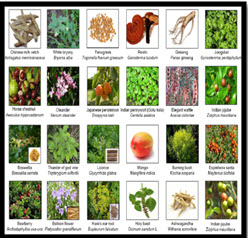
Fig.14 Triterpenoids Source
Rubus fairholmianus
Rubus fairholmianus is a berry used in folkloric medicine. The methanolic column subfraction of Rubus fairholmianus root (RFM) shows the presence of alpha-tocopherol, flavonol glycoside and apigenin. The methanolic column subfraction of Rubus fairholmianus root (RFM) significantly reduced solid and ascites tumors in mice in 100 mg/kg dose. The morphological features of RFM treated MCF-7 cells showed the cell damage and decreased cell numbers. The viability of treated cells decreased with 67.73% at 20 μg/mL against 96.50% in untreated cells. The treated cells (20 μg/mL) resulted in a substantial decrease (p < 0.001) in cellular ATP proliferation, increased the LDH cytotoxicity, increased apoptotic cells population (33.92%) and reduced the population of viable cells (Annexin V-/PI-) (45.56%). This is the first evidence about in vitro and in vivo anticancer activity of R. fairholmianus phenolics. The major phenolics such as alpha-tocopherol, flavonol glycoside, and apigenin might be the reason behind the caspase-mediated apoptosis. [George BP et al. 2017]

Fig.15 Rubus fairholmianus
Quercetin
The flavonoid quercetin (3,3',4',5,7-pentahydroxyflavone) is present in plants, foods, and beverages and shows antioxidant, radical-scavenging, anti-inflammatory, antibacterial, antiviral, gastroprotective and immune-modulator. Besides, quercetin is used in neurological disorders and having protection against mitochondrial damages. The various in vitro studies showed the anticancer effects of quercetin, but there mechanism of action is not known. The quercetin has low bioavailability, poor solubility, rapid body clearance, fast metabolism and enzymatic degradation which restrict the use of quercetin as therapeutic agent, so intense research focused on the modification of the quercetin scaffold to obtain analogs with potentially improved properties for therapeutic use.[ Massi A et al. 2017]
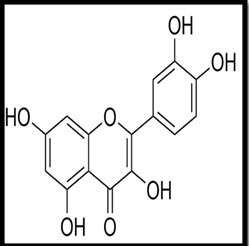
Fig.16 Structure of Quercetin
Stephania tetrandra
The fangchinoline, alkaloid from Stephania tetrandra, has inactivator of nuclear NR4A1 and it inhibits cell proliferation via the NR4A1-dependent pro-apoptotic pathways in human pancreatic cancer cells. It decreased expression of the antiapoptotic protein survivin by inhibiting Sp1-mediated transcription and induced oxidative stress-mediated endoplasmic reticulum (ER) stress in pancreatic cancer cells. [Lee HS et al. 2017]

Fig.17 Stephania tetrandra
NOW YOU CAN ALSO PUBLISH YOUR ARTICLE ONLINE.
SUBMIT YOUR ARTICLE/PROJECT AT editor-in-chief@pharmatutor.org
Subscribe to Pharmatutor Alerts by Email
FIND OUT MORE ARTICLES AT OUR DATABASE
Saussurea lappa
The ethanolic extract of Saussurea lappa (ESL) has curative effect against prostate cancer. ESL treatment decreased the viability of LNCaP cells and increased Bax expression while suppressing the expression of pro-caspases-8/9/3, PARP, Bid, and Bcl-2, thereby inducing apoptosis in LNCaP cells. So it shows that ESL exerts anticancer effects through the induction of both cellular apoptosis and autophagy, and apoptotic cell death can be facilitated by blocking autophagy in ESL-treated LNCaP cells. Therefore, ESL might be a potential anticancer agent for the treatment of prostate cancer.[ Tian X et al. 2017]
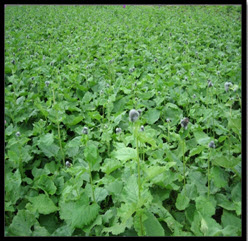
Fig.18 Saussurea lappa
Cordia dichotoma
Mechanisms of antioxidant and apoptosis induction may be involved in the management of cancer by medicinal plants. The methanolic extract of Cordia dichotoma leaves (MECD) shows anticancer activity against a human prostate carcinoma cell line, PC3. Flavonoid content was found to be 160 mg QE/g extract. IC50 values for MECD treatment in various assays based on scavenging of 2,2-diphenyl-1-picrylhydrazyl, 2,2-azinobis(3-ethylenebenzothiazoline-6-sulfonic acid), nitric oxide, peroxy radical, superoxide anion, hydroxy radical were found to be 315.5, 38, 476, 523, 197, 82 μg/ml respectively. MECD exposure to PC3 cells significantly increased the cell death (p < 0.001, IC50 = 74.5 μg/ml), nuclear condensation, apoptosis (p < 0.001) and induced production of ROS (p < 0.001) initiating apoptotic cascade in a dose dependent manner. Flavonoids in MECD may be responsible for these activities due to dual antioxidant and pro-oxidant properties.[ Rahman MA et al. 2017]
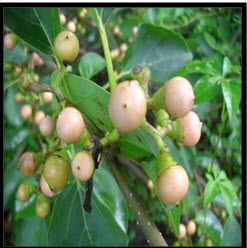
Fig.19 Cordia dichotoma
CONCLUSION
Cancer is a disease characterized by out-of-control cell growth. It is difficult to treat cancer. The available treatment for the cancer today is like chemotherapy, Radiation and surgery etc. But it is having various side effects. To minimize the side effect which caused by the chemotherapy we can use a plant-derived substance. So this review article gives information regarding some plant which acts as anticancer. And further, it encourages to explore different plants for the possibility of anticancer.
REFERENCE
1. Blazquez AG, Fernandez-Dolon M, Sanchez-Vicente L, Maestre AD, Gomez-San Miguel AB et al. Novel artemisinin derivatives with potential usefulness against liver/colon cancer and viral hepatitis. Bioorganic and Medicinal Chemistry 2013;21:4432-41
2. Derry M, Raina K, Agarwal R and Agarwal C. Differential effects of grape seed extract against human colorectal cancer cell lines: the intricate role of death receptors and mitochondria.Cancer letter 2013;334:69-78.
3. Friedman M, Mackey BE, Kim HJ, Lee IS, Lee KR, Lee SU et al. Structure-activityrelationships of tea compounds against human cancer cells. Journal of Agriculture and Food Chemistry 2007 ;55:243-53.
4. George BP, Abrahamse H, Hemmaragala NM. Phenolics from Rubus fairholmianus induces cytotoxicity and apoptosis in human breast adenocarcinoma cells. Chem Biol Interact. 2017;275:178-188.
5. Griffiths G, Trueman L, Crowther T, Thomas B, Smith B. Onions--a global benefit to health. Phytotherapy Research 2002;16:603-15
6. Gutheil WG, Reed G, Ray A, Anant S, Dhar A. Crocetin: an agent derived from saffron for prevention and therapy for cancer. Current Pharmaceutical Biotechnology 2012;13:173-9
7. Huang S, Yang N, Liu Y, Gao J, Huang T, Hu L et al. Grape seed proanthocyanidins inhibit colon cancer-induced angiogenesis through suppressing the expression of VEGF and Ang1. International journal of molecular medicine 2012;30:1410-6.
8. Jeong CH, Bode AM, Pugliese A, Cho YY, Kim HG, Shim JH et al.[6]-Gingerol suppresses colon cancer growth by targeting leukotriene A4 hydrolase. Cancer Research 2009;69:5584-91.
9. Jo EH, Hong HD, Ahn NC, Jung JW, Yang SR, Park JS et al. Modulations of the Bcl-2/Bax family were involved in the chemopreventive effects of licorice root (Glycyrrhiza uralensis Fisch) in MCF-7 human breast cancer cell. Journal of Agriculture and Food Chemistry 2004;52:1715-9.
10. Lee HS, Safe S, Lee SO. Inactivation of the orphan nuclear receptor NR4A1 contributes to apoptosis induction by fangchinoline in pancreatic cancer cells. Toxicol Appl Pharmacol. 2017 Oct 1;332:32-39. doi: 10.1016/j.taap.2017.07.017. Epub 2017 Jul 25. PubMed PMID: 28754437.
11. Lin JG, Chen GW, Li TM, Chouh ST, Tan TW, Chung JG et al. Aloe-emodin induces apoptosis in T24 human bladder cancer cells through the p53 dependent apoptotic pathway. Journal of Urology 2006;175:343-7.
12. Lindholm P, Gullbo J, Claeson P, Göransson U, Johansson S, Backlund A et al.Selective cytotoxicity evaluation in anticancer drug screening of fractionated plant extracts. Journal of Biomolecular Screening 2002;7:333-40.
13. Massi A, Bortolini O, Ragno D, Bernardi T, Sacchetti G, Tacchini M, De Risi C. Research Progress in the Modification of Quercetin Leading to Anticancer Agents. Molecules. 2017 Jul 29;22(8). pii: E1270. doi: 10.3390/molecules22081270. Review. PubMed PMID: 28758919.
14. Mohansrinivasan V, Subathra DC, Deori M, Biswas A and Jemimah NS. Exploring the Anticancer Activity of Grape Seed Extract on Skin Cancer Cell Lines A431. Brazilian Archives Of Biology And Technology 2015;58:540-6
15. Mokhtari MJ, Motamed N, Shokrgozar MA. Evaluation of silibinin on the viability, migration and adhesion of the human prostate adenocarcinoma (PC-3) cell line. Cell Biology International 2008;32:888-92.
16. Ochwang’I DO, Kimwele CN, Oduma JA, Gathumbi PK, Mbaria JM, Kiama SG. Medicinal plants used in treatment and management of cancer in Kakamega County Kenya. Journal of Ethnopharmacology. 2014;151:1040–1055.
17. Peron G, Marzaro G, Dall'Acqua S. Known triterpenes and their derivatives as scaffolds for the development of new therapeutic agents for cancer. Curr Med Chem. 2017 Aug 17. doi: 10.2174/0929867324666170818111933. [Epub ahead of print] PubMed PMID: 28820068.
18. Persia FA, Rinaldini E, Carrión A, Hapon MB, Gamarra-Luques C. Evaluation of cytotoxic and antitumoral properties of Tessaria absinthioides (Hook & Arn) DC, "pájaro bobo", aqueous extract. Medicina (B Aires) 2017;77:283-290.
19. Rahman MA, Sahabjada, Akhtar J. Evaluation of anticancer activity of Cordia dichotoma leaves against a human prostate carcinoma cell line, PC3. J Tradit Complement Med. 2016 Dec 4;7(3):315-321. doi: 10.1016/j.jtcme.2016.11.002. eCollection 2017 Jul. PubMed PMID: 28725626; PubMed Central PMCID: PMC5506664.
20. Rhode J, Fogoros S, Zick S, Wahl H, Griffith KA, Huang J et al. Ginger inhibits cell growth and modulates angiogenic factors in ovarian cancer cells. BMC Complement Alternative Medicine 2007 ;7:44.
21. Sigstedt SC, Hooten CJ, Callewaert MC, Jenkins AR, Romero AE, Pullin MJ et al. Evaluation of aqueous extracts of Taraxacum officinale on growth and invasion of breast and prostate cancer cells. International Journal of Oncology 2008;32:1085-90.
22. Sivaraj R, Rahman PKSM, Rajiv P, Vanathi P, Venckatesh R. Biosynthesis and characterization of Acalypha indica mediated copper oxide nanoparticles and evaluation of its antimicrobial and anticancer activity. Spectrochimica Acta Part A: Molecular and Biomolecular Spectroscopy. 2014;129:255–258.
23. Tian X, Song HS, Cho YM, Park B, Song YJ, Jang S, Kang SC. Anticancer effect of Saussurea lappa extract via dual control of apoptosis and autophagy in prostate cancer cells. Medicine (Baltimore). 2017 Jul;96(30):e7606. doi: 10.1097/MD.0000000000007606. PubMed PMID: 28746210.
24. Torres MP, Rachagani S, Purohit V, Pandey P, Joshi S, Moore ED et al. Graviola: a novel promising natural-derived drug that inhibits tumorigenicity and metastasis of pancreatic cancer cells in vitro and in vivo through altering cell metabolism. Cancer Letter 2012;323:29-40.
25. Wang ZY, Nixon DW. Licorice and cancer. Nutrition and Cancer. 2001;39:1-11.
NOW YOU CAN ALSO PUBLISH YOUR ARTICLE ONLINE.
SUBMIT YOUR ARTICLE/PROJECT AT editor-in-chief@pharmatutor.org
Subscribe to Pharmatutor Alerts by Email
FIND OUT MORE ARTICLES AT OUR DATABASE





